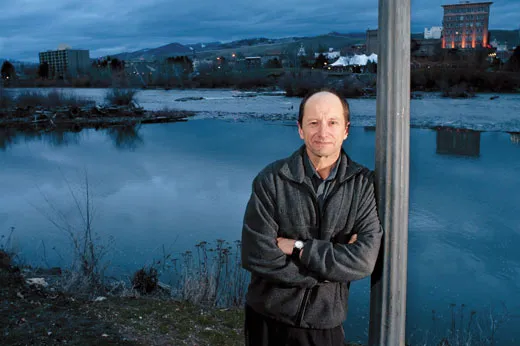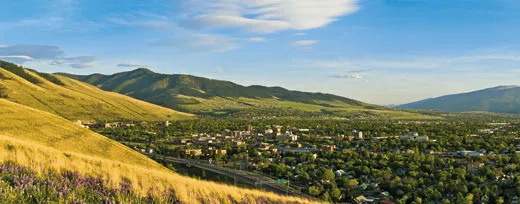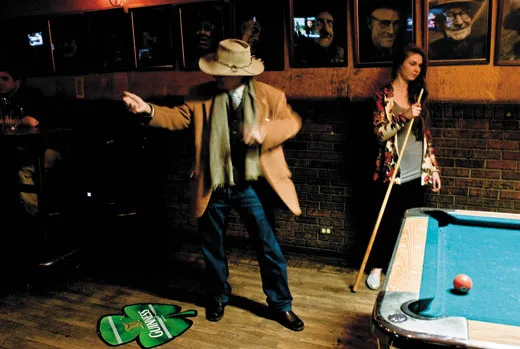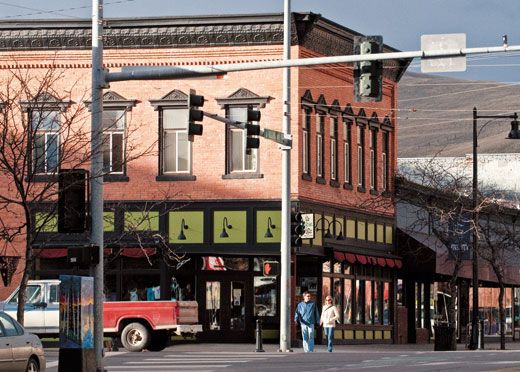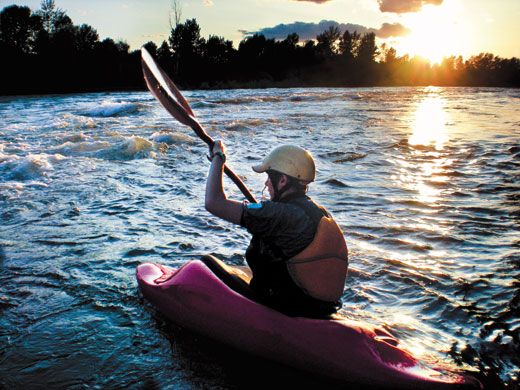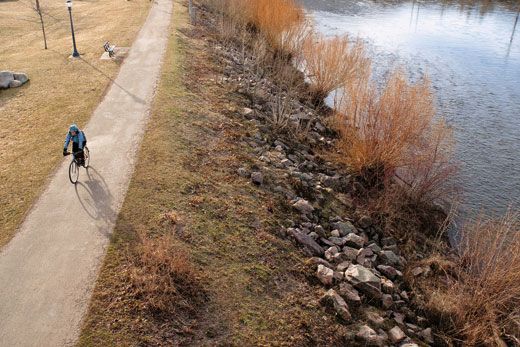Missoula: A Perfect Mix of Town and Country
Author Rick Bass trades wilderness for city life, Montana style
/https://tf-cmsv2-smithsonianmag-media.s3.amazonaws.com/filer/MKOT-Missoula-MT-city-631.jpg)
Many towns in the West consider themselves “outdoor” towns—suggesting a citizenry eager to bike, run, ski, paddle, hunt, fish, hike, backpack, float and camp. Missoula, Montana, is one of these towns, but it possesses some indefinable spirit that keeps it from being confused with any other. Many of the West’s outdoor towns lie farther south, and closer to larger population centers. Missoula still has space around it.
In autumn, Missoula swells to some 67,000 souls, but just when you think it will tip over into a seething metropolis, it contracts; students from the University of Montana flee for winter or spring break. In summer, people head for Yellowstone, Glacier, the Seeley-Swan, the Selway-Bitterroot, the Bob Marshall, the Rattlesnake, the Big Hole, the Missions—wilderness in all directions. The newly empty town breathes, relaxes. I moved here nearly three years ago from a desolate, wooded valley up on the Canadian border for the town’s highly regarded high schools, and have not been disappointed. I had to get used to the sounds of sirens, dogs, snowplows and the general low-level hiss of traffic, a contrast to the utter peace, stillness, silence, stars and dense sweet scent of the forest. But I can still see mountains.
More than any city or town I’ve known, Missoula balances out-of-door attractions and the arts. Missoula has hundreds, maybe thousands, of artists and writers, in part—but by no means exclusively—because of the university. It’s got a great library and great bookstores: Fact & Fiction, Shakespeare & Co., the Book Exchange, to name but a few. There’s a symphony, a children’s theater and numerous art galleries. And yet there’s healthy dirt between the cracks. The nightly river-rushing winds of Hellgate Canyon keep most things scoured clean.
Missoula has a reputation as a bastion of seething, crazed liberals—it is, after all, a university town—but in my opinion, while elsewhere there is often hostility, even venom, between political polarities, here there seems to be a dynamic stasis, a healthy—dare I use the word?—tolerance for one another, at least a desire for tolerance. Missoula was home to Jeannette Rankin, the first woman elected to Congress, in 1916, and the only member of Congress to vote against entering World War I and World War II.
The town has a close-cousin relationship with Butte, 120 miles southeast, a historic player in the nation’s labor movement, where, in 1878, a contingent of 400 silver miners refused a pay cut from $3.50 a day to $3. They formed the Butte Workingmen’s Union, leading Butte to become known as the “Gibraltar of Unionism.”
But Missoula is mostly about the land beyond the town—the protected open space—and the grudging respect residents have for each other, no matter their political beliefs, due to the shared good luck—and pluck—of being Montanans. Most people live in Montana because it’s the place they want to be.
Many western towns are, in my opinion, canted a little off-center: a tad too hot in summer, or possessing just a bit too much winter. Missoula, however, is a land of four distinct, almost perfect seasons. Like all outdoor-minded people, we inhabit the current season, whichever it is, with passion, though we also take great pleasure in anticipating the next one as well.
Winters are somber, gray, severe; gray skies press down like a heavy boot. Magpies peck at wizened ash berries. Frozen dog dirt stipples the tundra of the golf course. Loud music seeps from blue-glowing bars, neon light spills onto icy sidewalks, the lanes are crusted with road salt.
Then comes the spring, with the explosiveness of longer days and songbirds returning to the willows along the Clark Fork River, which flows through the center of town, east to west. Bald eagles and ospreys roost in the old cottonwoods that line the gravel shores. In summer, children and adults alike bob in the rushing Clark Fork in inner tubes. A white-water pool was constructed right beneath the downtown bridge, where you can stop on the pedestrian walkway and watch kayakers and surfers practice in the wave. Wild ducks jet up and down the blue waters in spring and autumn, and fly fishermen wade the riffles, casting leisurely. As the Seine divides yet unites Paris, so too does the Clark Fork cleave—yet weave—a more robust Missoula.
Numerous creeks and rivers meet in the broad valley, each bringing a certain chemistry and vigor, melding with the valley to create their places of convergence. The creeks Rattlesnake, Butler, Lolo, Rock and Deep shimmer and surge; the Blackfoot and the Bitterroot rivers join the Clark Fork just outside of town.
Upstream is the poisonous Berkeley Pit, an open-pit mine in Butte, which was once called the Richest Hill on Earth for the quantities of gold, silver and copper mined there. Rather than accepting the toxins from the remnants of mines in the upper river valley, Missoula has set about cleaning them up. A local group, the Clark Fork Coalition, works to restore the watershed and helped remove a failing dam that was storing dangerous levels of toxins, so now the Clark Fork runs free again. Other groups have formed to protect entire mountains surrounding the town.
The university is committed to being carbon neutral by 2020. The city council is fighting plans for Imperial Oil, a Canadian subsidiary of ExxonMobil, to transport massive petroleum equipment—on trailers 200 feet long and three stories high—over historic Lolo Pass and through downtown Missoula, en route to the oil sands mining in Alberta. I’m betting on Missoula.
Tuck into urbane country fare at the Pearl; fresh, sustainably grown local foods at the Red Bird; simple yet sophisticated bistro dishes at Scotty’s Table or incredible Italian food at Caffé Dolce. Indulge in late night coffee and sweets at Break Espresso and ice cream at Big Dipper, where, if you’re lucky, they’ll be serving the mango habanero sorbet. Shop for fresh seafood (Seattle is eight hours away by car) at Pattee Creek Market. Of course, there are local breweries and several farmer’s markets.
Missoula has a developing local music scene as well—folk singers Kira Means and Michelle Dufflocq Williams, not yet out of high school, have already recorded CDs—including longtime guitar favorites Amy Martin, David Boone and John Floridis. The Decemberists’ frontman, Colin Meloy, hails from here, as does the Broken Valley Roadshow bluegrass band, and a hot new group, Stellarondo. The old Wilma Theatre is a funky, lovely, ornate riverside venue. There’s also a vinyl record shop, Ear Candy, and the obligatory music and gag gift store, Rockin Rudy’s.
Missoula is a place where, when your dog slips her collar, you can check the animal shelters or post an ad on the public radio station, where someone is more likely to have her safe than to have turned her in. My German shorthaired pointer has broken free so many times that the local radio announcers have learned how to pronounce her name, Auna (Awn-uh). In her most recent escapade, she ran to the nearest high school—crossing several busy streets to get there—hopped in the back of a truck headed south and ended up near Hamilton, almost 50 miles away. She has one of those newfangled chips in her; a vet there scanned her, and her finders called me.
Living here is sweet, if you must live in a town. I’ll get back to the woods some day. I’m just treading water. In the meantime, I stand on the bridge at night and watch the Clark Fork glimmer, reflecting Missoula’s lights as the river hurries past.
Rick Bass is the author of 25 books. His most recent is the novel Nashville Chrome.
